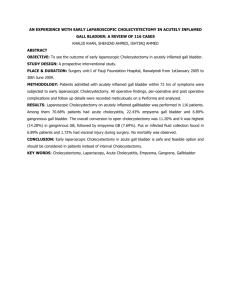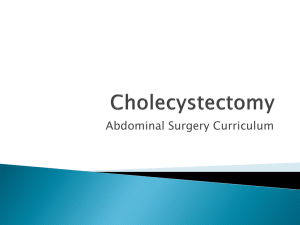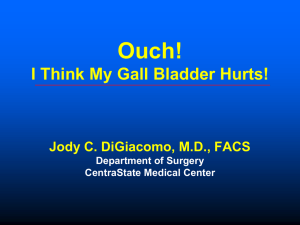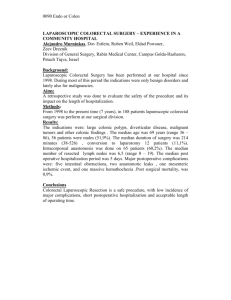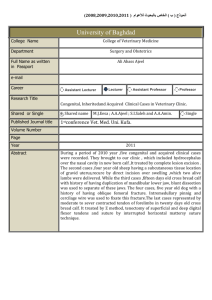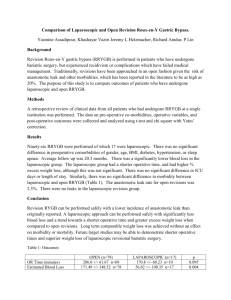unmed a chandak ,arti mitra,manish singh,prashant agarwal,ritesh
advertisement
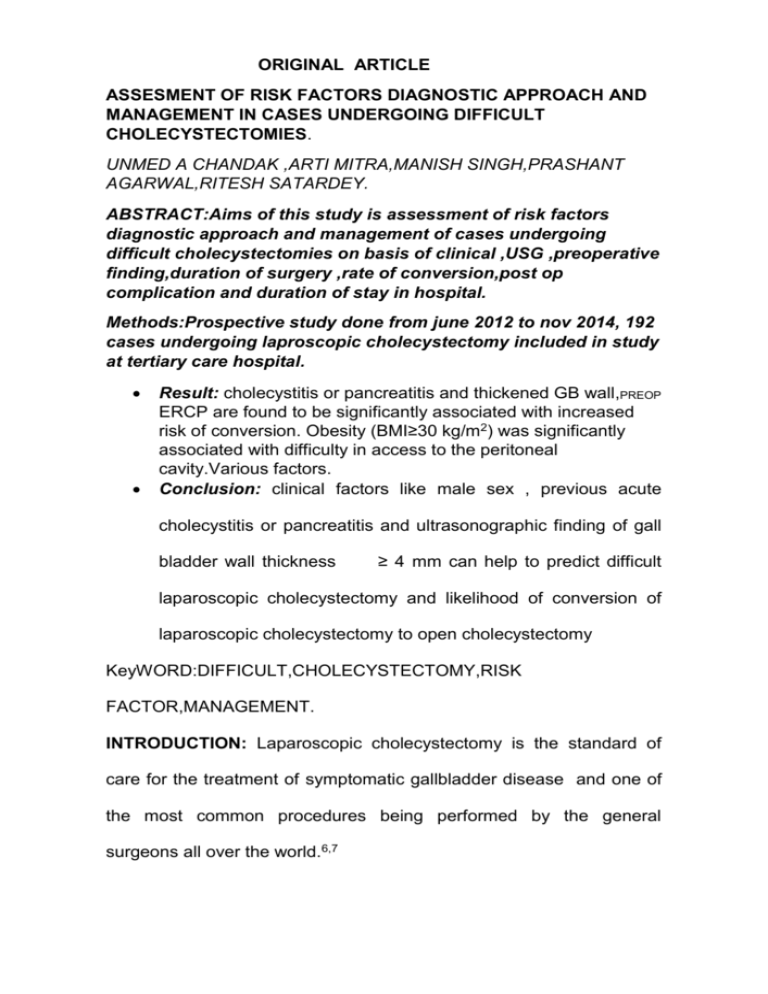
ORIGINAL ARTICLE ASSESMENT OF RISK FACTORS DIAGNOSTIC APPROACH AND MANAGEMENT IN CASES UNDERGOING DIFFICULT CHOLECYSTECTOMIES. UNMED A CHANDAK ,ARTI MITRA,MANISH SINGH,PRASHANT AGARWAL,RITESH SATARDEY. ABSTRACT:Aims of this study is assessment of risk factors diagnostic approach and management of cases undergoing difficult cholecystectomies on basis of clinical ,USG ,preoperative finding,duration of surgery ,rate of conversion,post op complication and duration of stay in hospital. Methods:Prospective study done from june 2012 to nov 2014, 192 cases undergoing laproscopic cholecystectomy included in study at tertiary care hospital. Result: cholecystitis or pancreatitis and thickened GB wall,PREOP ERCP are found to be significantly associated with increased risk of conversion. Obesity (BMI≥30 kg/m2) was significantly associated with difficulty in access to the peritoneal cavity.Various factors. Conclusion: clinical factors like male sex , previous acute cholecystitis or pancreatitis and ultrasonographic finding of gall bladder wall thickness ≥ 4 mm can help to predict difficult laparoscopic cholecystectomy and likelihood of conversion of laparoscopic cholecystectomy to open cholecystectomy KeyWORD:DIFFICULT,CHOLECYSTECTOMY,RISK FACTOR,MANAGEMENT. INTRODUCTION: Laparoscopic cholecystectomy is the standard of care for the treatment of symptomatic gallbladder disease and one of the most common procedures being performed by the general surgeons all over the world.6,7 With more and more endeavors being made in the field of laparoscopy, more and more complicated cases which were relatively contraindicated a few years ago, are now being tackled laparoscopically. Laparoscopic cholecystectomy decreases postoperative pain, allows earlier oral intake, shortens hospital stay, enhances earlier return to normal activity, and improves cosmetics over open cholecystectomy8,9,10 However, approximately 2% to 15% of patients require conversion to open surgery for various reasons9-11. Identifying preoperative variables predicting conversion to open surgery improves patient counseling, planning of convalescence, and postoperative expectations. In addition, the surgeon can appropriately predict operative times while maintaining a lower threshold for conversion when intraoperative difficulties are encountered. These predictive factors for conversion also improve patient safety, minimizes the intraoperative complications . aims and objectives: 1. To study the parameters preoperative that can Ultrasonographic predict difficult & Clinical laparoscopic cholecystectomy. To determine the per operative findings suggestive of difficult laparoscopic cholecystectomy. establish management approach in term of To operative time, conversion rates, intra operative and post operative complications, duration of hospital stay.. Material and methods: Study Setting : A Tertiary Care Hospital and Institute draining a large rural population of central India, Study Duration: JUN 2012 to November 2014. Study Design : A Hospital based Non Randomized Prospective Study. All patients undergoing laparoscopic cholecystectomy were included in the study. Exclusion criteria 1. Patients unfit for general anesthesia and surgery. 2. Patients refusing to undergo surgery. Criteria for prediction of difficult laparoscopic cholecystectomy CLINICAL Stocky Male patients Multiparous female with flabby abdomen Pregnancy Liver Cirrhosis Present or previous Acute cholecystitis or pancreatitis USG BASED PEROPERATIVE Thickened GB wall ≥4mm Polyp/mass lesion Edematous GB Emphysematous GB Contracted non functioning GB Perforated GB Impacted GB stone Empyema GB Difficulty in Access Difficulty in GB dissection Bleeding Abnormal Anatomy GB perforation Viscus perforation Intracorporeal suturing TREATMENT: Surgical (a) laparoscopic cholecystectomy (b) laparoscopic cholecystectomy converted cholecystectomy . (c) open cholecystectomy. to open STATISTIC: Reasons Continuous variables (Age , Duration of surgery) were presented as Mean± SD, Categical variables were expressed in actual number and percentages. Continuous variables were compared by performing unpaired t-test .Categorical variables were compared by chi-square statistics. For small numbers, fisher exact test was applied wherever applicable. RESULT: TABLE 1 PRE OPEARTIVE RISK FACTOR NUMBER ADHESION PRESENT N=30 ABSENT N=150 Local Signs Of Cholecystitis Present 32 12 20 Absent 160 21 139 Pre Op ERCP Done 18 6 12 Not Done 174 27 147 None 168 32 136 Thick (≥4) 32 10 22 Normal 160 23 137 Normal 139 22 117 GB Wall Thickness TABLE 2 NUMBE R DURATION OF SURGERY PVALU E Present 32 76.09 ±22.71 <0.00 01, (HS) Absent 160 59.42 ±27.25 PRE OPERATIVE RISK FACTOR Local Signs Of Cholecystitis PVALUE 0.001 (HS) 0.003, HS 0.021 (S) GB Wall Thickness Liver Multiple 149 63.97 ±29.47 ≥4 32 84.34 ±43.23 <4 160 57.78 ±20.18 Fatty 53 58.91 ±25.31 Normal 139 63.46 ±27.34 TABLE 3 INTRA OP COMPLICATION NUMBE R PERCEN T Bleeding 12 46.15 GB Perforation 08 30.76 Duodenal Perforation 01 03.84 Stone Spillage 05 19.23 POST OP COMPLICATION NUMBER PERCENT Fever 03 30 Wound Infection 4 40 Delayed Bleeding 02 20 Delayed Bile Leak 1 10 REASON FOR CONVERSION (TABLE 4) Difficult GB Dissection 10 58.82 Intra Operative Bleeding 04 23.52 0.000 1, (HS) 0.30, NS GB Perforation 02 18.18 Duodenal Perforation 01 5.88 TABLE 5 PRE OPEARTIVE RISK FACTOR Gender GB Wall Thickness History of Acute Cholecystitis / Pancreatitis NUMBER CONVERSION TO OPEN PVALUE COMPLETED CONVERTED Male 76 64 12 Female 116 111 5 Non Obese 146 135 11 None 168 152 16 Thick 32 22 10 Normal 160 153 7 Present 08 5 3 Absent 184 169 15 DISCUSSION: The incidence; In present study, 76 patients were males and 116 patients were females.. The male:female ratio in this study is 1: 1.53 which compares well with the study of Kimura K et al(1992)11. (TABLE 2)In our study, in presence of local signs of cholecystitis and thickened GB wall ≥4mm , pre op ercp ,duration of surgery was significantly higher.(p<0.001). 0.006, (HS) <0.001, (HS) 0.01, (S) Abdel Baki et. al.(2006)12 in their study commented that patients with local signs of cholecystitis ,single impacted stones, thickened GB wall and liver fibrosis had significantly higher operative time(p<0.05). In our study, presence of dense adhesions during surgery was correlated with various variables out of which history of local sign of cholecystitis was significantly associated with presence of dense adhesions(p<0.001). Preoperative ERCP,past history of acute cholecystitis or acute pancreatitis and GB wall thickness 4mm or more were also positively associated with presence of dense adhesions intra operatively, (p<0.003 ,p<0.012and p<0.021 respectively) . Jagadish Nachnani et.al.(2005) 14 in his study commented that past history of abdominal surgery, past history of acute cholecystitis/pancreatitis and thickened GB wall were associated with difficulty in defining the anatomy. Acute cholecystitis/pancreatitis results in a scarred and fibrosed GB and in dense fibrotic adhesions that render laparoscopic dissection difficult. In present series, (Table No.2) mean operative time required for laparoscopic cholecystectomy is 62.2min; while mean time required for Difficult cases is 90.56 minutes whereas mean operating time for converted procedures is 121.58 min which is significantly higher as compared to non converted cases. Porte RJ15 et al in 1996 conducted a study over 200 patients and found that the mean operating time for laparoscopic cholecystectomy was 75 min (40-140)min. The mean operating time in the study by Sciume C16 et al (2005) was 65.03 min (30-180min). In our study, duration of surgery was correlated with various preoperative risk factors (Table No. 2) and various variables studied were presence or absence of local signs of cholecystitis, number of stones, thickened GB wall, status of liver,pre op ERCP& past history of acute cholecystitis or acute pancreatitis . In our study, in presence of signs local of cholecystitis and thickened GB wall ≥4mm , pre op ercp ,duration of surgery was significantly higher.(p<0.001). Abdel Baki et. al.(2006)12 in their study commented that patients with local signs of cholecystitis ,single impacted stones, thickened GB wall and liver fibrosis had significantly higher operative time(p<0.05). Ahmet Alponat et al.13 in his study showed these signs to be a significant predictor of difficulty and hence conversion to open. In our study, duration of surgery was correlated with various preoperative risk factors (Table No.2) and various variables studied were presence or absence of local signs of cholecystitis, number of stones, thickened GB wall, status of liver,pre op ERCP& past history of acute cholecystitis or acute pancreatitis . In our study, in presence of local signs of cholecystitis and thickened GB wall ≥4mm , pre op ercp ,duration of surgery was significantly higher.(p<0.001). Abdel Baki et. al.(2006)12 in their study commented that patients with local signs of cholecystitis ,single impacted stones, thickened GB wall and liver fibrosis had significantly higher operative time(p<0.05). Ahmet Alponat et al.13 in his study showed these signs to be a significant predictor of difficulty and hence conversion to open. In our study, in presence of local signs of cholecystitis and thickened GB wall ≥4mm , pre op ercp ,duration of surgery was significantly higher.(p<0.001). CONCLUSION Mean age of difficult laparoscopic cholecystectomy was highest in the age group of 31-40 years, showing incidence of 23.5%. The mean age incidence undergoing difficult laparoscopic cholecystectomy in present study was 43.6 years.Chronic calculus cholecystitis is the commonest mode of presentation in this study.In clinical factors, male gender, previous acute cholecystitis or pancreatitis and thickened GB wall are found to be significantly associated with increased risk of conversion.Preoperative ultrasonographic finding of gall bladder wall thickness ≥4mm is significantly associated with increased risk conversion.Preoperative ERCP significantly increases the number of difficult cases and increases the risk of conversion to open & can help to predict difficult laparoscopic cholecystectomy .Obesity (BMI≥30 kg/m2) was significantly associated with difficulty in access to the peritoneal cavity.Various factors like thickened GB wall, presence of local signs of cholecystitis and preoperative ERCP were significantly associated with difficulty in GB dissection and dense adhesions causing difficulty in performing laparoscopic cholecystectomy.. In present series , mean operative time required for difficult laparoscopic cholecystectomy is 89.92 min; while mean time required for converted procedures is 121.58 min which is highly significant as compared to operative time for non converted cases which is 68.75 minutes.Significant bleeding occurred more often in patients with past history of acute cholecystitis or pancreatitis and those patients having gall bladder wall thickness ≥ 4m.The common reasons for conversion in present study were as follows-dense adhesions(57.9%), bleeding(21.1%),GB perforation (10.5%) and intra operative viscus perforation (10.5%).As more and more number of cases were performed laparoscopically, conversion rate was significantly reduced.The conversion rate of laparoscopic cholecystectomy to open cholecystectomy is 9.64% overall and 29.69 % in difficult cases which is slightly higher in our study and can be explained on the basis of less experience in difficult cases, early phase of learning curve and lack of technological advances. Patients with a high predicted operated on either by or under risk of conversion could be the supervision of a more experienced surgeon. Also, a high predicted risk of conversion may allow the surgeon to take an early decision to convert to OC when difficulty is encountered during dissection; this may significantly shorten the duration of surgery and decrease the associated morbidity. BIBLIOGRAPHY 1.Molmenti EP, Pinto PA, Klein J et al: : Normal and variant arterial supply of liver and gallbladder. Paediatric Transplant 2003; 07: 80. 1. Strasberg SM, Sanabria JR, Clavien PA: Complications of laparoscopic cholecystectomy. Clin J Surg 1992; 35(3):275280. 2. Peters JH, Gibbons GD, Innes JT et al: Complication of laparoscopic cholecystectomy.Surg1991; 110:769-778. 3. Shehadi WH: The biliary system through the ages. Int Surg 1979;64:63. 4. Palanivelu C.,Jani K,Maheshkumar GS: experience of laparoscopic Single centre cholecystectomy.Journal Laaroendosc Adv Surg Tech A. 2007;17(5): 608-14. 5. Malhotra SL et al.:Epidemiology study of Cholelithiasis among railroad wrkers in India with special reference to causation.Gut 1968;9:290-95. 6. Wani et.al.: Experience with calculus biliary tract surgery. Ind J Surg 1995; 57: 181-188. 7. Shyamal Kumar et.al. : Etiopathogenesis of chronic cholecystitis in gangetic west Bengal-A study of 300 cases.Ind J surg 1995;57:309-312. 8. Hussain A et.al.: Laparoscopic cholecystectomy can be safely performed in a resource limited setting : the first 49 laparoscopic cholecystectomy in Yemen.JSLS;2008:12(1):71-76. 9. Kama Na et.al.: Risk factors resulting in conversion of laparoscopic cholecystectomy to open surgery.Surg Endosc.2001 Sep;15:965-68 10. Kimura K et.al.:Prospective study of laparoscopic cholecystectomy in two hundered and fifty patients Endoscopy 1992;24(9):740-44. 11. Abdel Baki et.al. Laparoscopic Pre-Operative Cholecystectomy Prediction Using of Difficult Clinical and Ultrasonographic Parametes. JMRI,2006;Vol.27 No.3:(102-07). 12. Ahmet Alponat et al. Predictive Factors for Conversion of Laparoscopic Cholecystectomy World J. Surg. 21, 629–633, 1997. 13. Jagdish Nachnani, Avinash Supe. Preoperative prediction of difficult laparoscopic ultrasonographic Cholecystectomy parameters. using Indian clinical journal and of Gatroenterology,2005;24:16-18. 14. Porte R J et.al.Laparoscopic versus open cholecystectomy: A prospective matched cohort study.HPB surgery 1996;9(2):7175. 15. Sciume C et.al. Video laparoscopic cholecystectomy :personal experience. Ann Ital Chir 2005;76(3):229-34
